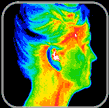Follow Us x
Thermography Pricing
Digital Infrared Thermal Imaging
What's Infrared Imaging?
Digital infrared thermal imaging is a non-invasive clinical imaging procedure for etching and monitoring a number of diseases and physical injuries, by showing the thermal abnormalities present in the body. Images or 'Thermograms' can be taken of the whole body or just areas being investigated. The digitized images are stored in a computer and sent electronically to a thermologist (board certified medical doctor) for interpretation.
- No radiation
- Non-invasive
- FDA cleared imaging systems
This quick and easy test starts with your medical history being taken before you partially disrobe for the scanning to be performed
Single region of interest exams can take approximately 30 minutes and a full body 60 minutes.

- Regions of Interest (ROI) - $175 or $275 for 2 regions
- Half body scan - $355
- Fully body scan- $425
- Includes: head, neck, breast/chest, back, abdomen, upper and lower extremities
Breast Thermography
The benefit of Thermography is that it offers the opportunity of earlier detection of breast disease than has been possible through breast self examination, doctor examination or mammography alone. This quick and easy test starts with your medical history being taken before you partially disrobe for the scanning to be performed. Two thermograms, three months apart, are required to establish a baseline. A subsequent session assures that the patterns remain unchanged. All of your thermograms (breast images) are kept on record and once your stable thermal pattern has been established any changes can be detected during your routine annual studies.
The benefits
- Opportunity to detect changes earlier than through self examination, doctor examination and diagnostic testing alone
- Contactless
- No raditaion
- Results within 48 hours
- Breast Screening: $175 per first visit
- Two appointments 3 months apart are required to establish a baseline.
- Breast & ROI: $275 Includes Breast and your choice of one of the following: Head/neck, Abdomen, Lower extremities, Upper extremities
- Women's Health Check: $355 Includes: head, neck, breasts, back, and abdomen
Immune Health Check
Monitor your immune system with DITI (Digital Inferred Thermal Imaging)
Thermography has the ability to evaluate and monitor many of the markers relating to autonomic dysfunction and other burdens on the immune systems. This procedure is for those who are vulnerable or higher-risk adults with underlying medical problems such as cardiovascular disease, diabetes, chronic respiratory disease, and cancer who are more likely to suffer from the effects of post-viral and vaccine syndromes that can be difficult to diagnose.
Maintain better health with Thermography. A simple, non-contact scan to aid diagnosis and prognosis, and for monitoring therapy progress for many conditions and injuries.
Including:
- Skin cancer
- Breast disease
- Stroke screening
- Digestive disorders
- Artery Inflammation
- Vascular disease
- Carpal tunnel syndrome
- Back injuries
- Arthritis
- Headache
- Nerve damage
- Unexplained pain
- Fibromyalgia
- RSD (CRPS)
- Dental and TMJ
- Disc Disease
Immune Health Check: $175.00
This type of screening can be the first level indicator of physiological changes relating to existing or developing autoimmune dysfunction.


